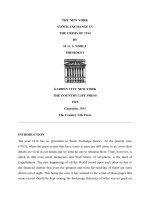Carol Dweck Mindset The New Psy - w.godfrey
Bạn đang xem bản rút gọn của tài liệu. Xem và tải ngay bản đầy đủ của tài liệu tại đây (1.54 MB, 813 trang )
CONTENTS
Cover Page
Title Page
Introduction
1. HE MINDSETSWhy Do People
Differ?What Does All This Mean for
You? The Two
MindsetsA View from the Two
MindsetsSo, What’s New?Self-Insight:
Who Has Accurate Views of Their
Assets and Limitations?What’s in Store
2. NSIDE THE MINDSETS Is
Success About Learning—Or Proving
You’re Smart?Mindsets Change the
Meaning of FailureMindsets Change
the Meaning of EffortQuestions and
Answers
3. HE TRUTH ABOUT ABILITY
AND ACCOMPLISHMENT Mindset
and School AchievementIs Artistic
Ability a Gift?The Danger of Praise
and Positive LabelsNegative Labels
and How They Work
4. PORTS: THE MINDSET OF A
CHAMPION The Idea of the
Natural“Character”What Is Success?
What Is Failure?Taking Charge of
SuccessWhat Does It Mean to Be a
Star?Hearing the Mindsets
5. BUSINESS: MINDSET AND
LEADERSHIP Enron and the Talent
MindsetOrganizations That GrowA
Study of Mindset and Management
DecisionsLeadership and the Fixed
MindsetFixed-Mindset Leaders in
ActionGrowth-Mindset Leaders in
ActionA Study of Group
ProcessesGroupthink Versus We
ThinkAre Leaders Born or Made?
6. RELATIONSHIPS: MINDSETS
IN LOVE (OR NOT) Relationships
Are DifferentMindsets Falling in
LoveThe Partner as
EnemyCompetition: Who’s the
Greatest?Developing in
RelationshipsFriendshipShynessBullies
and Victims: Revenge Revisited
7. PARENTS, TEACHERS, AND
COACHES: WHERE DO
MINDSETS COME FROM?Parents
(and Teachers): Messages About
Success and FailureTeachers (and
Parents): What Makes a Great Teacher
(or Parent)?Coaches: Winning
Through MindsetOur Legacy
8. CHANGING MINDSETS: A
WORKSHOP The Nature of
ChangeThe Mindset LecturesA Mindset
WorkshopBrainologyMore About
ChangeTaking the First Step: A
Workshop for YouPeople Who Don’t
Want to ChangeChanging Your Child’s
MindsetMindset and
WillpowerMaintaining ChangeThe
Road Ahead
NotesRecommended BooksAbout the
AuthorCopyright
INTRODUCTION
One day, my students sat me down and
ordered me to write this book. They
wanted
people to be able to use our work to
make their lives better. It was something
I’d wanted to do
for a long time, but it became my number
one priority.
My work is part of a tradition in
psychology that shows the power of
people’s beliefs.
These may be beliefs we’re aware of or
unaware of, but they strongly affect what
we want and
whether we succeed in getting it. This
tradition also shows how changing
people’s beliefs—even
the simplest beliefs—can have profound
effects.
In this book, you’ll learn how a simple
belief about yourself—a belief we
discovered in
our research—guides a large part of
your life. In fact, it permeates every part
of your life. Much
of what you think of as your personality
actually grows out of this “mindset.”
Much of what may
be preventing you from fulfilling your
potential grows out of it.
No book has ever explained this mindset
and shown people how to make use of it
in their
lives. You’ll suddenly understand the
greats—in the sciences and arts, in
sports, and in
business—and the would-have-beens.
You’ll understand your mate, your boss,
your friends, your
kids. You’ll see how to unleash your
potential—and your children’s.
It is my privilege to share my findings
with you. Besides accounts of people
from my
research, I’ve filled each chapter with
stories both ripped from the headlines
and based on my
own life and experience, so you can see
the mindsets in action. (In most cases,
names and
personal information have been changed
to preserve anonymity; in some cases,
several people
have been condensed into one to make a
clearer point. A number of the exchanges
are re-created
from memory, and I have rendered them
to the best of my ability.)
At the end of each chapter and
throughout the last chapter, I show you
ways to apply the
lessons—ways to recognize the mindset
that is guiding your life, to understand
how it works, and
to change it if you wish.
A little note about grammar. I know it
and I love it, but I haven’t always
followed it in
this book. I start sentences with ands and
buts. I end sentences with prepositions. I
use the plural
they in contexts that require the singular
he or she. I’ve done this for informality
and immediacy,
and I hope that the sticklers will forgive
me.
I’d like to take this chance to thank all of
the people who made my research and
this book
possible. My students have made my
research career a complete joy. I hope
they’ve learned as
much from me as I’ve learned from them.
I’d also like to thank the organizations
that supported
our research: the William T. Grant
Foundation, the National Science
Foundation, the Department
of Education, the National Institute of
Mental Health, the National Institute of
Child Health and
Human Development, and the Spencer
Foundation.
The people at Random House have been
the most encouraging team I could wish
for:
Webster Younce, Daniel Menaker, Tom
Perry, and, most of all, Caroline Sutton,
my editor. Your
excitement about my book and your great
suggestions have made all the difference.
I thank my
superb agent, Giles Anderson, as well as
Heidi Grant for putting me in touch with
him. Thanks to all the people who gave
me input and feedback, but special
thanks to Polly
Shulman, Richard Dweck, and Maryann
Peshkin for their extensive and insightful
comments.
Finally, I thank my husband, David, for
the love and enthusiasm that give my life
an extra
dimension. His support throughout this
project was extraordinary.
My work has been about growth, and it
has helped foster my own growth. It is
my wish
that it will do the same for you.
Chapter 1
THE MINDSETS
When I was a young researcher, just
starting out, something happened that
changed my
life. I was obsessed with
understanding how people cope with
failures, and I decided to study it by
watching how students grapple with hard
problems. So I brought children one at a
time to a room in their school, made
them comfortable, and then gave them a
series of puzzles to solve. The first ones
were fairly easy, but the next ones were
hard. As the students grunted, perspired,
and toiled, I watched their strategies and
probed what they were thinking and
feeling. I expected differences among
children in how they coped with the
difficulty, but I saw something I never
expected.
Confronted with the hard puzzles,
one ten-year-old boy pulled up his chair,
rubbed his hands together, smacked his
lips, and cried out, “I love a challenge!”
Another, sweating away on these
puzzles, looked up with a pleased
expression and said with authority, “You
know, I was hoping this would be
informative!”
What’s wrong with them? I
wondered. I always thought you coped
with failure or you didn’t cope with
failure. I never thought anyone loved
failure. Were these alien children or
were they on to something?
Everyone has a role model, someone
who pointed the way at a critical
moment in their lives. These children
were my role models. They obviously
knew something I didn’t and I was
determined to figure it out—to
understand the kind of mindset that could
turn a failure into a gift.
What did they know? They knew that
human qualities, such as intellectual
skills, could be cultivated through effort.
And that’s what they were doing—
getting smarter. Not only weren’t they
discouraged by failure, they didn’t even
think they were failing. They thought they
were learning.
I, on the other hand, thought human
qualities were carved in stone. You
were smart or you weren’t, and failure
meant you weren’t. It was that simple. If
you could arrange successes and avoid
failures (at all costs), you could stay
smart. Struggles, mistakes, perseverance
were just not part of this picture.
Whether human qualities are things
that can be cultivated or things that are
carved in stone is an old issue. What
these beliefs mean for you is a new one:
What are the consequences of thinking
that your intelligence or personality is
something you can develop, as opposed
to something that is a fixed, deep-seated
trait? Let’s first look in on the age-old,
fiercely waged debate about human
nature and then return to the question of
what these beliefs mean for you.
WHY DO PEOPLE DIFFER?
Since the dawn of time, people have
thought differently, acted differently, and
fared differently from each other. It was
guaranteed that someone would ask the
question of why people differed—why
some people are smarter or more moral
—and whether there was something that
made them permanently different.
Experts lined up on both sides. Some
claimed that there was a strong physical
basis for these differences, making them
unavoidable and unalterable. Through
the ages, these alleged physical
differences have included bumps on the
skull (phrenology), the size and shape of
the skull (craniology), and, today, genes.
Others pointed to the strong differences
in people’s backgrounds, experiences,
training, or ways of learning. It may
surprise you to know that a big champion
of this view was Alfred Binet, the
inventor of the IQ test. Wasn’t the IQ test
meant to summarize children’s
unchangeable intelligence? In fact, no.
Binet, a Frenchman working in Paris in
the early twentieth century, designed this
test to identify children who were not
profiting from the Paris public schools,
so that new educational programs
could be designed to get them back on
track. Without denying individual
differences in children’s intellects, he
believed that education and practice
could bring about fundamental changes
in intelligence. Here is a quote from one
of his major books, Modern Ideas About
Children, in which he summarizes his
work with hundreds of children with
learning difficulties:
A few modern philosophers . . . assert
that an individual’s intelligence is a
fixed quantity, a quantity which cannot
be increased. We must protest and react
against this brutal pessimism. . . . With
practice, training, and above all, method,
we manage to increase our attention, our
memory, our judgment and literally to
become more intelligent than we were
before.
Who’s right? Today most experts
agree that it’s not either–or. It’s not
nature or nurture, genes or environment.
From conception on, there’s a constant
give and take between the two. In fact,
as Gilbert Gottlieb, an eminent
neuroscientist, put it, not only do genes
and environment cooperate as we
develop, but genes require input from
the environment to work properly.
At the same time, scientists are
learning that people have more capacity
for lifelong learning and brain
development than they ever thought. Of
course, each person has a unique genetic
endowment. People may start with
different temperaments and different
aptitudes, but it is clear that experience,
training, and personal effort take them
the rest of the way. Robert Sternberg, the
present-day guru of intelligence, writes
that the major factor in whether people
achieve expertise “is not some fixed
prior ability, but purposeful
engagement.” Or, as his forerunner Binet
recognized, it’s not always the people
who start out the smartest who end up
the smartest.
WHAT DOES ALL THIS MEAN
FOR YOU? THE TWO MINDSETS
It’s one thing to have pundits spouting
their opinions about scientific issues.
It’s another thing to understand how
these views apply to you. For twenty
years, my research has shown that the
view you adopt for yourself profoundly
affects the way you lead your life. It can
determine whether you become the
person you want to be and whether you
accomplish the things you value. How
does this happen? How can a simple
belief have the power to transform your
psychology and, as a result, your life?
Believing that your qualities are carved
in stone—the fixed mindset—creates an
urgency to prove yourself over and over.
If you have only a certain amount of
intelligence, a certain personality, and a
certain moral character—well, then
you’d better prove that you have a
healthy dose of them. It simply wouldn’t
do to look or feel deficient in these most
basic characteristics.
Some of us are trained in this mindset
from an early age. Even as a child, I was
focused on being smart, but the fixed
mindset was really stamped in by Mrs.
Wilson, my sixth-grade teacher. Unlike
Alfred Binet, she believed that people’s
IQ scores told the whole story of who
they were. We were seated around the
room in IQ order, and only the highest-
IQ students could be trusted to carry the
flag, clap the erasers, or take a note to
the principal. Aside from the daily
stomachaches she provoked with her
judgmental stance, she was creating a
mindset in which everyone in the class
had one consuming goal—look smart,
don’t look dumb. Who cared about or
enjoyed learning when our whole being
was at stake every time she gave us a
test or called on us in class?
I’ve seen so many people with this one
consuming goal of proving themselves—
in the classroom, in their careers, and in
their relationships. Every situation calls
for a confirmation of their intelligence,
personality, or character. Every situation
is evaluated: Will I succeed or fail?
Will I look smart or dumb? Will I
be accepted or rejected? Will I feel like
a winner or a loser? But doesn’t our
society value intelligence, personality,
and character? Isn’t it normal to
want these traits? Yes, but . . .
There’s another mindset in which these









